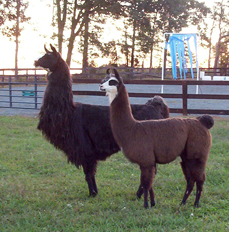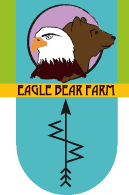It’s a funny thing how llamas came into our lives at EBF. We certainly weren’t looking for more “kids” but we had just tragically lost our beloved Thoroughbred, QP, and needed to quickly get a companion for Josh (he had been raised from 5mos old by QP and never been alone). My friend, Penny Bolhorst, offered to bring a couple of llamas down…”just for a trial basis”. I had never had llamas so I was a bit resistant, especially not knowing what all is entailed in llama husbandry! In the meantime, Dakota (our PMU foal from Canada) joined our brood. I decided to have Penny bring the llamas anyway. Well, I can’t imagine our lives without llamas now! They bring us so much joy and are the lowest maintenance member of anything and anyone on the farm. Even our boarders love having them around.
Llamas as Companion Animals
Llamas make excellent companion animals. They bond quickly to horses and have none of the herd hierarchy problems that you have with other horses, donkeys or mules. They are also angelic compared to the animal world’s “Dennis the Menace”, goats! I had to re-fence our entire farm when a horse came to board that had a goat for a companion. The goat even bullied the horse away from its food – not a good thing since the horse was elderly and needed every calorie!
They also quickly learn who is supposed to be on the farm and who isn’t (see herd protection) Another nice aspect of the llamas as companions is that even though they bond with the horse(s), there are never any herd-bound issues when either is removed from the other. A BIG plus!
Llamas as Herd Protection
Llamas have a long history of herd protection among sheep and goat Ranchers. Although they look quite docile in the herd, they can very effectively attack and kill predators, such as coyotes, wolves, pack dogs, bob cats, etc. I personally witnessed our very sweet duo of Katie (“Mama Llama”) and Frankie, come out of their run-in and fix on something on our front fence line before I even saw anything. It was a pack of dogs casing our pasture. They followed the dogs until they left the area. It was an amazing thing to watch!
One wonderful added benefit of herd protection is of VERY special importance to horse and livestock owners. We have absolutely NO ground hogs in the pastures the llamas have access to. One day my husband saw a very large ground hog (think beagle size!) come into our pasture from the back neighbor’s field. My husband dearly wanted to shoot the poor beast (I told him to never tell me about it if he did) but he never had a chance! Katie charged the ground hog and chased him out of the pasture with one warning stomp (PNHers…think “ask, tell, promise”) followed by the “I really mean it” pounce. Just to point out how effective they are – the llamas had not been allowed in the hay pasture. We had a ground hog hole in the hay pasture.
A few more unexpected but delightful benefits – we never had deer in their pasture, AND I had absolutely no rabbits or other invaders in my organic garden (the llama pasture surrounds the fenced garden)
Llamas as the True Easy Keepers
Most of us know what’s involved in horse care – even those of us with 24/7 turnout! But, there is no comparison with ease of llamas. One acre can feed up to 5 llamas….our 2 share the pasture with 7 horses. We’ve established a little run-in area for them that allows them shelter and access to hay and minerals without having to compete with the horses (they always defer to horses in those cases so this is their own area that horses can’t access but they can duck under a fence board to get to). They eat maybe a flake of hay over 2-3 days when grass is available. Each llama gets about ¼-1/3 lb of llama feed a day. They need their feet trimmed periodically (being a Natural Barefoot Trimmer for horses, I can assure you llamas are easier!) and they need a worm shot about every 3 mos. In the spring, we shear the wool. Penny Bolhorst is available to perform these tasks for you (see her link). Containment is a breeze! As compared to trying to build Fort Knox for the goat, a simple rope can pen a llama. Transporting is also simple: they travel easily in things as small as minivans (!) – they lie down while traveling.
Llamas and Their Many Uses
Llama wool is fabulous. For those of us that can’t get within a mile of sheep’s wool without coming unglued with itchiness, llama wool is a blessing! Its luxurious softness is wonderful. As mentioned above, Penny Bolhorst is available to shear your llama and will either process the wool for you or sell it.
We have tried a little Parelli training with our llamas with mixed results but they are very easily trained for things such as performance, trail/packing, and obstacle courses, especially when using clicker training. Llamas are even currently being used to visit hospitals and assisted care facilities.
Llamas as Pets and Members of Your Farm
Llamas have a wonderful gentleness about them. They are quick to run up and greet you – frequently nuzzling your face with rabbit-like noses. They are very playful, especially at dusk, when they can be seen bounding around and bouncing off each other. You can usually find your llama’s special itchy spot which they will from that point forward, place within your reach. I am also thrilled to report that we have never had any of our llamas spit -- a frequent question we get.
As mentioned earlier, we can’t imagine life at EagleBear Farm without llamas.
Check out the links for pictures and llamas for sale. Drop us an email with any questions or come visit!
|



